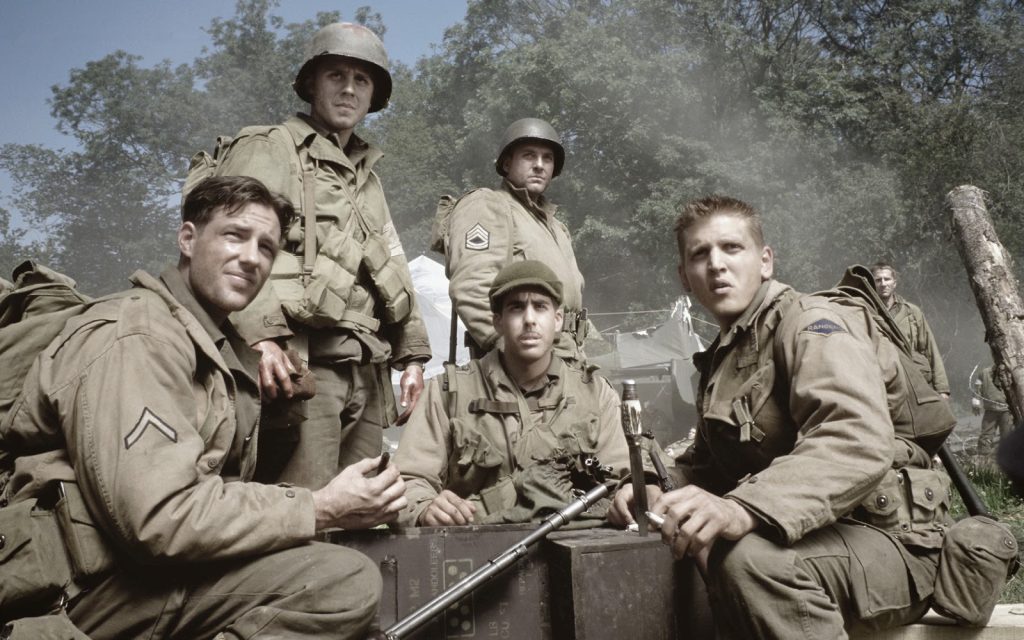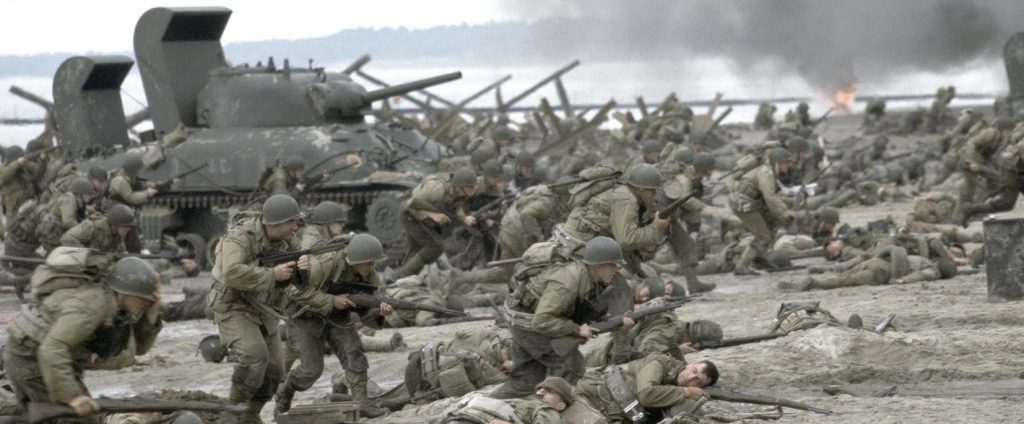Although Ireland itself remained neutral during World War II, Irish Americans provided some of that war’s most celebrated heroes. There were aviators Colin Kelly, Thomas B. McGuire, and Edward H. O’Hare, as well as infantryman Audie Murphy, the baby-faced Texan who went from being the most highly decorated American serviceman of the war to a career recreating his own exploits on screen.
An equally enduring place in the national heroic mythos is reserved for the Sullivans, the five Irish American brothers from Iowa who perished on the same ship, the U.S.S Juneau, in 1942. Hollywood paid tribute to the Sullivans’ sacrifice with a 1944 movie bearing their name. With the Sullivan Law barring brothers from serving on the same ship, the Navy took steps to ensure that such a family catastrophe could never happen again.
Steven Spielberg’s overwhelmingly powerful film Saving Private Ryan — the story of a mission to rescue the last surviving son (Matt Damon) of a family that lost three other boys in one week of World War II — cites the precedent of the Sullivans as well as alluding to them in the title character’s Irish name and Midwestern roots. The closest historical parallel to the rescue of Private James Ryan was an incident involving a New York family which lost three other sons in one week of combat in 1944, including two in the Normandy Invasion. After the mother received all three telegrams from the War Department in a single day, a chaplain was sent to bring back her remaining son. But unlike in the movie, the rescue was accomplished without further incident, and the family was not Irish (the surviving soldier was Private Fritz Niland).
With the movie’s Irish echoes and antecedents, it’s somehow poetically fitting, even if coincidental, that its mind-boggling, twenty-five-minute recreation of D-Day (an opening sequence that renders the rest of the film somewhat anticlimactic) was shot on an Irish location. Production designer Tom Sanders found a close equivalent to Normandy’s Omaha Beach at Ballinesker, a thousand-yard stretch of Curracloe beach in County Wexford. Part of the attraction of the site was the cooperation of the Irish government, both with tax incentives and in supplying more than 900 Army and FCA (the Irish equivalent of the National Guard).
The Irish weather also cooperated, providing suitably overcast skies during the three weeks of D-Day filming in June and July 1997. When the first bright sunlight appears well into the picture, the effect on cinematographer Janusz Kaminski’s desaturated color palette is as startling and disorienting as it would have seemed to men on the ground in 1944.
But claiming Saving Private Ryan as an “Irish war movie” would run contrary to its anti-jingoistic mood. Although Spielberg bookends the film with shots of a waving American flag, that image is largely drained of color, implying that any postwar patriotic celebration of “the last good war” can, at best, be a pale reflection of what these men experienced. The film’s one serious false step is the mawkish framing device of an elderly veteran returning to the site of the invasion; it’s so overplayed that its bathos becomes unintentionally alienating.

The ostensible prize of the mission, Private Ryan himself, seems largely incidental to the film’s overall vision of the war as much greater than any individual concern. When Captain John Miller (Tom Hanks) and his small squad finally locate Ryan, he doesn’t want to go home — he wants to finish out his duty with his handful of surviving comrades (“the only brothers I have left”). By downplaying Ryan’s narrative centrality and resuscitating the World War II-movie chiché of the multiethnic American squadron, Spielberg underscores the egalitarian nature of the war. True to the grunt’s tightly close-up picture of war, there are few overt references to the reasons the war was being fought. There is, however, an echo of the searing anger of Schindler’s List when the squad’s Jewish member, Private Mellish (Adam Goldberg), taunts passing German prisoners with his Star of David, telling them, “I’m Juden…Juden.” Even more moving is an earlier moment in the aftermath of the assault on Omaha Beach, when Mellish unexpectedly collapsing with emotion when he is handed a knife taken from the body of a member of the Hitler Youth.
Like most Spielberg movies (even Schlndler’s List), Saving Private Ryan aims for the broadest identification, focusing largely on “Mr. Everyday Regular Fella,” the phrase the director likes to use for his Everyman protagonists. Here the audience surrogate figure is our closest contemporary equivalent of Jimmy Stewart, Tom Hanks, whose emotional and verbal reticence as Captain Miller encourages the audience to project its own emotions into the character. Miller’s melancholic calmness and mature self-control are reminiscent of the PT boat commander played by Robert Montgomery’s in John Ford’s They Were Expendable (1945), the most somber and responsible of Hollywood World War II movies and a particular favorite of Spielberg’s.
Spielberg’s visual style also owes much to John Huston’s great Army documentary San Pietro (1943) and to the D-Day photos of Robert Capa. But Saving Private Ryan invades new terrain for a large scale Hollywood war movie with its graphic honesty in depicting battlefield carnage. In Spielberg’s body of work, the closest equivalent to its unrelentingly raw, jagged-edged, nerve-wracking depiction of combat may be his 1962 amateur featurette Escape to Nowhere, which plunges the viewer into the chaotic search for a GI trapped behind German lines.
Spielberg’s long obsession with World War II stems equally from his acute feelings of vulnerability over his Jewish heritage and from his conflicted relationship with his father, Amold, who served during the war as a radio operator with the Army Air Forces in the China-Burma-India Theater of Operations. Over the past few years, the filmmaker has been going through a salutary process of personal reconciliation with his father. Arnold was Steven’s partner on their early movies recreating the war when it was still a recent memory for most Americans. Making Savlng Private Ryan, and centering it as he does on the quiet heroism of Hanks’s low-key father-figure, can be seen as Steven Spielberg’s act of reconciliation not only with his own father but also with that entire generation of brave but modest men who served in the war and later had a hard time explaining to their sons what it was all about.
Editor’s Note: This article was originally published in the September/October 1998 issue of Irish America. ⬥


Leave a Reply